
Bulletin
wall bulletinMenu
- Overview
- Country analysis
- Afghanistan
- Angola
- Argentina
- Australia
- Bangladesh
- Belarus
- Brazil
- Canada
- Germany
- Egypt
- Ethiopia
- France
- United Kingdom
- Hungary
- Indonesia
- India
- Iran
- Italy
- Kazakhstan
- Kenya
- Cambodia
- Sri Lanka
- Morocco
- Mexico
- Myanmar
- Mongolia
- Mozambique
- Nigeria
- Pakistan
- Philippines
- Poland
- Romania
- Russia
- Thailand
- Turkey
- Ukraine
- United States
- Uzbekistan
- Viet Nam
- South Africa
- Zambia
- Kyrgyzstan
Authors: 超级管理员 | Edit: zhaoxf
In Belarus the reporting period includes the planting of spring wheat and summer crops until June and the harvest of winter wheat from July. The nationwide rainfall amount reached 352 mm, which was 11% above average. However, solar radiation (RADPAR -3%) and temperature (-1.0°C) fell below the 15YA average, the potential biomass was decreased by -7% and lower than average. Agronomic conditions were shown as favorable: very good values of VCIx (0.97) and cropped arable land fraction (CALF, 100%) were observed.
The NDVI development graph was generally below 5-year average from Apirl to early May and recovered in June. The spatial pattern showed diverse patterns. In about 69.1% of cropped area crop condition was close to or above 5-year average. Only 11.4% of cropped areas were 0.1 NDVI units below the average, mostly scattered in the south-east and along the western border. Average national VCIx exceeded 0.97, indicating fair crop prospects in most crop area. Overall, although agronomic conditions were satisfactory in this period, water shortage in previous months during spring might have constrained crop growth, and more solar radiation will be needed to ensure good winter wheat production and summer crop development.
Regional analysis
Based on cropping system, climatic zones and topographic conditions, regional analyses are provided for three agro-ecological zones (AEZ), including Northern Belarus (028, Vitebsk, northern area of Grodno, Minsk and Mogilev), Central Belarus (027, Grodno, Minsk and Mogilev and Southern Belarus (029) which includes the southern halves of Brest and Gomel regions.
North Belarus (Vitebsk, northern area of Grodno, Minsk and Mogilev) recorded a minor radiation deficit (-4%) combined with lower temperature (-1.0°C) and higher rainfall (+13%). BIOMSS decreased 8% below average. The VCIx had reached 0.99, and CALF had reached 100%. The NDVI development curve was below or close to average in April and early May and slightly higher in June. Crop overall condition is normal.
Central Belarus (Grodno, Minsk and Mogilev) also experienced higher rainfall (12%) and lower temperature (-1.0°C) and less sunshine (-2%). Potential biomass decreased about 6%. High CALF (100%) and VCIx (0.97) were also recorded. Similar to northern Belarus, the NDVI growth curve remained close to the average trend from April to May but showed recovery since June.
Precipitation in Southern Belarus was higher by 14%, while temperature and radiation were slightly lower by 1.0°C and 2%, respectively. Potential biomass was expected to decrease by 7%. The CALF and the VCIx were100% and 0.95 respectively. Although agronomic indicators showed that crop growth was generally favorable, the impact of water shortage in spring and radiation deficit in this period on the crops requires close attention. The average NDVI development curve suggests that from April to June, crop condition was general below average for most of the time.
Figure 3.10 Belarus’s crop condition, April - July 2020

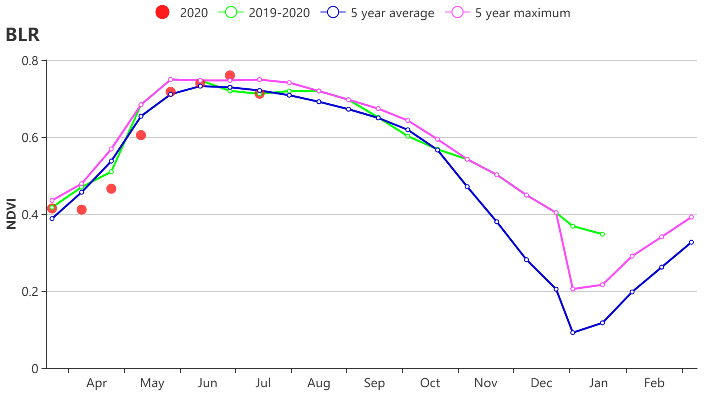
(b) Crop condition development graph based on NDVI

(c) Maximum VCI

(d) Spatial NDVI patterns compared to 5YA (e) NDVI profiles
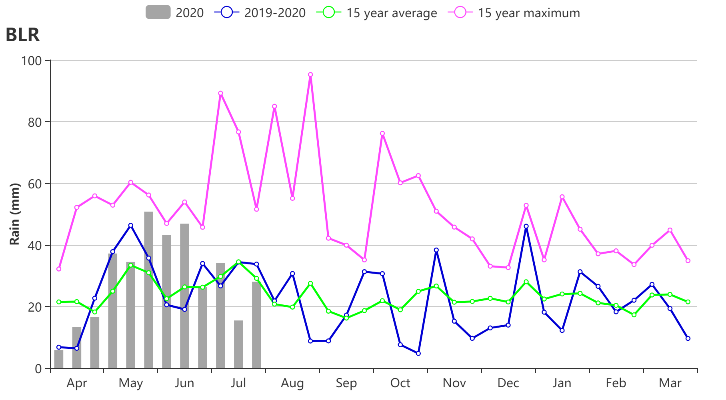
(f) Rainfall time series
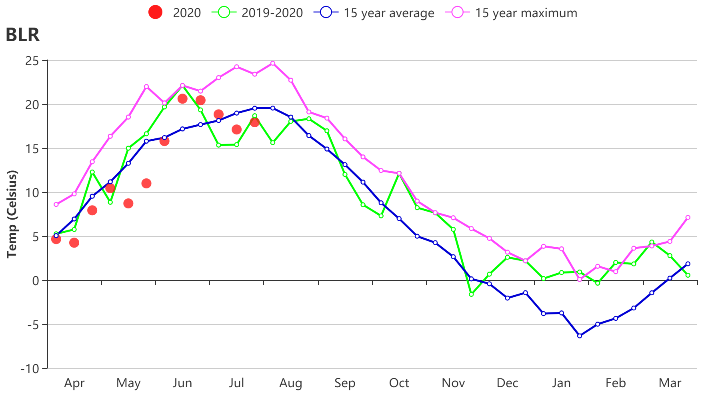
(g) Temperature time series
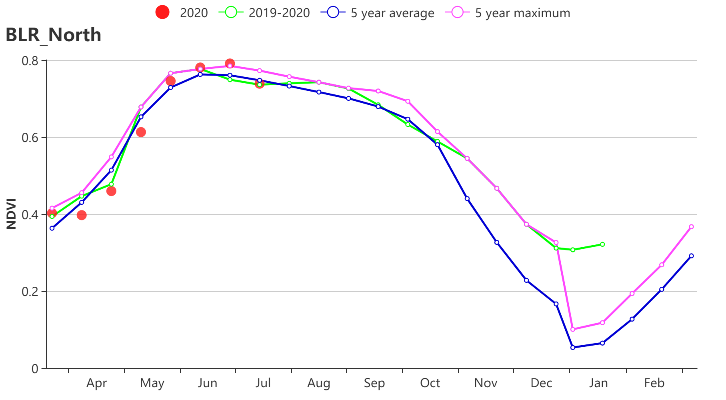
(h) Crop condition development graph based on NDVI (Northern Belarus)

(i) Crop condition development graph based on NDVI (Central Belarus)
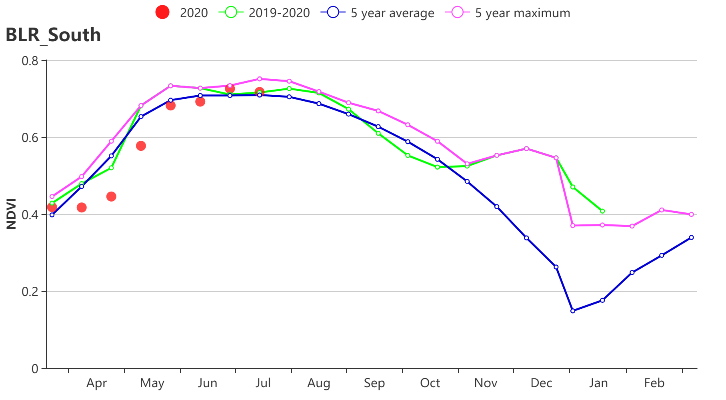
(j) Crop condition development graph based on NDVI (South-west Belarus)
Table 3.11 Belarus’s agroclimatic indicators by sub-national regions, current season’s values and departure from 15YA, April – July 2020.
Region | RAIN | TEMP | RADPAR | BIOMSS | |||||
Current (mm) | Departure (%) | Current (°C) | Departure (°C) | Current (MJ/m2) | Departure (%) | Current (gDM/m2) | Departure (%) | ||
Center | 353 | 12 | 13 | -1.0 | 1095 | -2 | 427 | -6 | |
North | 369 | 13 | 12 | -1.0 | 1054 | -4 | 386 | -8 | |
South-west | 312 | 4 | 14 | -1.0 | 1114 | -2 | 455 | -7 | |
Table 3.12 Belarus’s agronomic indicators by sub-national regions, current season’s values and departure from 5YA, April – July 2020
Region | Cropped arable land fraction | Maximum VCI | |
Current (%) | Departure (%) | Current | |
Center | 100 | 0 | 0.97 |
North | 100 | 0 | 0.99 |
South-west | 100 | 0 | 0.95 |
